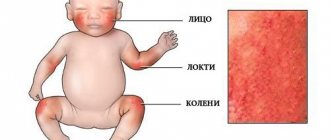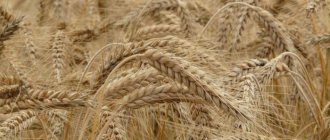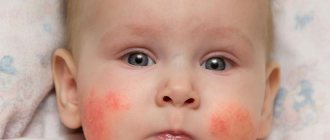Relevance of the problem
In the last decade, this type of hypersensitivity in children under 12 months of age has acquired new features:
- very early appearance;
- high prevalence;
- combined manifestations of allergies with symptoms from the digestive tract.
Cow's milk protein antigens are considered the strongest allergens. Milk contains more than 40 allergens.
The most dangerous are:
- caseins;
- bovine serum albumin;
- beta-lactoglobulin;
- alpha-lactalbumin.
Risk factors for food hypersensitivity to cow's milk proteins:
- hereditary predisposition;
- artificial feeding;
- consumption of large amounts of dairy products by a nursing mother;
- diseases of the gastrointestinal system in newborns;
- early introduction of complementary foods including dairy products.
What is protein?
People need to consume protein in foods for their bodies to function.
Protein is a substance that affects the body. People need to consume protein in foods for their bodies to function. Protein is a combination of amino acids that resemble a chain. When protein enters the gastrointestinal tract, enzymes destroy the structure of the chain. It splits into pieces. When the protein chain is broken down into several parts, the body can absorb the substance.
High protein content is found in milk, dairy products, animal meat and fish. In addition to protein, dairy products contain casein, alpha-lactoglobulin, and serum albumin.
How is an allergy to cow protein characterized in an infant?
Symptoms in the form of a skin rash - atopic dermatitis - are typical for very young children. Most often, at the age of 2 - 3 months, mothers may notice redness in the baby’s cheeks. Redness may either disappear or intensify.
Subsequently, bubbles appear at the site of the rash, which burst, and a weeping surface is formed, covered with crusts. The baby is very bothered by itching. In advanced forms of allergies, the rash can cover the child’s entire body.
In some special cases, allergic immune reactions to milk in a child may manifest as hives - the appearance of itchy blisters on the body. Against the background of urticaria, allergic swelling of the face, eyelids, and lips may appear.
Do not forget that in children allergic processes can imitate pathologies of the gastrointestinal system. Such manifestations complement the skin symptoms. Gastrointestinal manifestations include vomiting, intestinal colic, loose stool, and increased gas formation.
In children in the first month of life, the process of allergic inflammation in the tissues of the esophagus can be accompanied by severe pain and refusal of breast milk, reminiscent of the picture of pyloric spasm.
Main features
When parents consider the question “a child has a protein allergy, symptoms of its manifestations,” the answer is: depending on what type of protein the reaction occurs, specific symptoms may differ.
If we consider infants, then, for example, an atypical reaction to milk protein manifests itself:
- the appearance of diarrhea;
- severe colic;
- weight loss;
- loss of appetite;
- the appearance of insomnia.
Common features are:
- Swelling.
- Hyperemia of the skin.
- Rashes. The presence of a rash in the folds of the skin is typical, which confuses young mothers, and they mistake the allergy for diaper rash.
- The appearance of milky crusts on the child’s head (under the hair).
- Severe itching.
- Difficulty breathing.
- Nausea, attacks of vomiting.
- Since the allergen enters the body with food, in almost all cases allergic manifestations, one way or another, affect the gastrointestinal tract, and characteristic symptoms arise:
- colic;
- flatulence;
- constipation, alternating with diarrhea;
- deterioration of appetite or its complete absence.
- In babies over one year of age, manifestations on the mucous membrane are also observed. May be present:
- runny nose;
- nasal congestion;
- conjunctivitis;
- bronchial asthma.
Parents should know that when an allergy appears, even just one of the above symptoms may be observed, but cases where there is a whole complex of them are also possible.
Why do allergies to cow's milk antigens occur?
These processes are associated with a decrease in the protective functions of the immune system to food allergens.
Even in the prenatal period, the type of response of the immune system is laid down. In the presence of hereditary prerequisites, the Th-2 type of immune reaction is formed.
Allergens can penetrate the placenta and also enter the fetus through amniotic fluid.
In children, due to physiological characteristics, there is immaturity of the digestive tract. An increased antigenic load on the intestinal wall can trigger the formation of an allergic reaction.
Specific immunoglobulins E from the mother, starting from the 20th week of pregnancy, are able to penetrate the placenta.
Treatment
The main method of treating food hypersensitivity is diet therapy.
If a small patient is breastfed, mothers are prescribed a special diet excluding dairy products. Mothers are also advised to avoid foods with a high allergenic potential - chocolate, coffee, spices, mushrooms, nuts, strawberries, sausages, canned food. Pasta, gluten-containing cereals and sugar are limited.
Children receiving formula milk are prescribed medicinal hydrolysate formulas.
What are hydrolysate mixtures?
Highly hydrolytic mixtures are obtained by enzymatic breakdown of the substrate - whey or casein - into peptides. Peptides have a low molecular weight, which means that by hydrolysis it is possible to reduce the allergenicity of the mixture hundreds of times. It will be useful for parents to familiarize themselves with the classification of hydrolysate mixtures.
Classification of highly hydrolytic mixtures
Based on the substrate undergoing hydrolysis, all mixtures are divided into casein and whey.
Casein is the least allergenic and is used for severe cases of allergies. Casein mixtures include Pregemestil, Frisopep AS, and Nutramigen. Whey mixtures are more nutritious and valuable in chemical composition. These include “Alfare”, “Nutrilon Pepti Allergy”.
According to the degree of substrate breakdown, mixtures are divided into:
- highly hydrolyzed - “Alfare”, “Neocate”, “Frisopep”;
- partially hydrolyzed preventive mixtures - “NAN GA”, “Frisolak GA”.
Based on the chemical composition, mixtures are divided into lactose-free, low and high lactose. There are also mixtures containing long-chain and medium-chain triglycerides.
For severe food allergies with disruption of the digestive tract, lactose-free casein mixtures are prescribed. Medium chain triglycerides significantly increase the digestibility of fats.
Symptoms that can help you recognize a protein allergy
The symptoms of this type of allergy are similar to the body's reaction to other foods. First of all, as a rule, rashes are observed on the skin. This may include rash, redness, dryness, flaking, itching or swelling. In the photo you can see the nature of skin reactions due to allergies.
In some cases, allergic runny nose, lacrimation, and swelling of the mucous membranes are observed. It is also possible to experience pain and itching in the eyes.
Digestive disorders are very common. This may include excessive gas, nausea, and poor appetite. Due to protein, stool may be disturbed, abdominal pain leads to tearfulness of the baby, he may be capricious, and in some cases sleep disturbance occurs.
Goat milk based formulas
Goat milk has a reduced content of casein and beta-lactoglobulin, and alpha-lactalbumin has a different structure. New Zealand produces Nanny and Nanny Golden Goat blends. The mixtures are well absorbed and have hypoallergenic properties.
“Amalthea” is an instant goat’s milk powder recommended for use in women during lactation and pregnancy in order to prevent allergic diseases in the baby.
Introduction of complementary foods
Complementary foods are administered as prescribed by a doctor.
Start with mono-component vegetable purees or lactose-free gluten-free cereals. From six months you can introduce canned meat puree from rabbit, horse meat, turkey, excluding beef and veal.
From 8 months of age, vegetable and cereal dishes with the addition of meat puree are introduced. You can give your baby apples, currants, cherries, yellow plums baked or in the form of compotes.
A child is not given cottage cheese, eggs or seafood until he is one year old.
Dietary prevention
For babies at risk of developing allergic reactions to cow's milk protein, hypoallergenic preventive formulas are recommended. For example, “NAS Hypoallergenic”, “Nutrilon GA”, “Hipp GA”. The mixtures are based on partially hydrolyzed peptides.
Breastfeeding is the main factor in preventing the development of food allergies, providing immunity from antigens. It is advisable to continue breastfeeding for at least six months in order to reduce the risk of allergic processes.
Nuts, peanuts, chicken eggs, milk, and seafood are excluded from a nursing mother's diet. Cow's milk is introduced after a year, chicken eggs after reaching 24 months, nuts and seafood are not recommended until 3 years of age.
Types of allergies
There are the following types of allergic reactions to protein products:
- Allergy to protein contained in milk. Casein often negatively affects the health of children with weakened immune systems or underdeveloped enzymatic systems; it is poorly absorbed and provokes the body’s immune response.
- Allergy to egg white. Typically, it occurs more often with chicken eggs; quail eggs are considered hypoallergenic and practically do not provoke an allergic reaction. The primary symptoms of this type of allergy appear during the first 24 hours and will persist until the product is completely eliminated from the child’s diet. It is worth considering that the body’s reaction will appear not only when consuming protein directly, but also if the child eats cookies, pies or sauces that contain it.
- Allergy to fish protein and seafood. They are especially common in populated areas where the consumption of such products is predominant. As a rule, the main cause is hereditary predisposition. Such allergies can be identified in early childhood. If there is no predisposition, allergic reactions may develop against the background of an excess of fish products in the child’s diet, that is, due to a multiple effect.
- Allergy to meat protein. Often occurs along with milk allergy. In childhood, the body may react acutely to beef or veal. In this case, it is necessary to remove them from the baby’s diet, and sometimes completely eliminate meat dishes until the age of one.
- Nut allergy. It has no age restrictions and is incurable. What is typical is that even with very small concentrations of this product in the dishes consumed, a child may develop a severe allergy. The most aggressive are peanuts, followed by almonds and walnuts.
You can read about food allergies and other types:
- for milk;
- in the sun;
- on cats;
- on dogs;
- to red;
- for ambrosia.
Memo to parents
Cow's milk protein antigens are considered the strongest allergens. For very young children, manifestations of food hypersensitivity to cow's milk proteins in the form of a skin rash - atopic dermatitis - are typical. What parents need to know:
- An increased antigenic load on the intestinal wall can trigger the formation of an allergic reaction.
- The main method of treating food allergies is diet therapy.
- Highly hydrolyzed mixtures are obtained by enzymatic breakdown of the substrate - whey or casein - into peptides. Peptides have a low molecular weight, and through hydrolysis it is possible to reduce the allergenicity of the mixture hundreds of times.
- Breastfeeding is the main factor in preventing the development of cow's milk allergy in infants, providing immunity from food antigens.
- For babies at high risk of developing allergic processes, hypoallergenic preventive formulas are recommended.
Treatment of milk allergy
The first thing a doctor should do is examine a child with allergies and take tests.
If a child has symptoms of a milk allergy, you need to contact an allergist to begin treating the disease. The first thing the doctor should do is examine the child with allergies and take tests. By collecting tests, you can identify the cause of an allergic reaction and distinguish it from pseudo-allergy. When the allergen is identified, the doctor prescribes treatment.
It is necessary to exclude all foods that cause allergies in the child. It is necessary to give him antihistamines for children, which will relieve allergy symptoms. The main thing is to strictly adhere to the dosage of the drug prescribed by the doctor.










